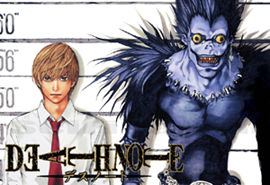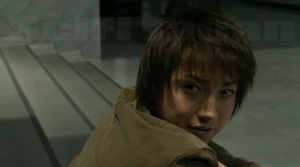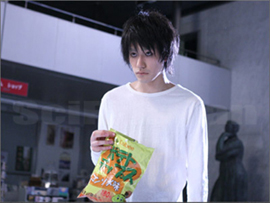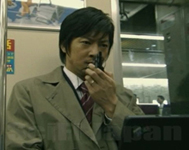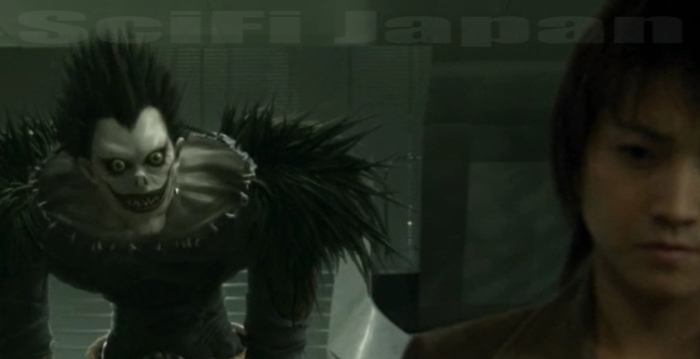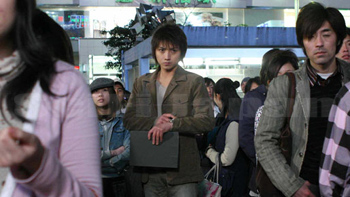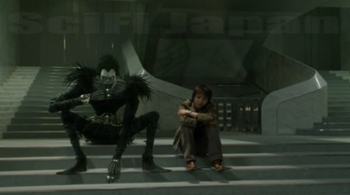A Brief History and Review of the Manga and Movie Author: Elliot Gay Source: DEATH NOTE Official Movie Guide, AFM, NTV, Death Note, Box Office Mojo, The Ones Who Never Lie, various Japanese Material Translated by: Elliot Gay Special Thanks to Keith Aiken and James Ballard
 The English language international sales flyer for DEATH NOTE. Photo courtesy of NTV. © 2006 [Death Note] Film Partners
The English language international sales flyer for DEATH NOTE. Photo courtesy of NTV. © 2006 [Death Note] Film PartnersDEATH NOTE (Desu Noto) Domestic Distribution: Warner Bros. Japan, Released June 17, 2006 International Sales: Nippon Television Network Corporation Japanese with English Subtitles, 126 minutes Official Movie Site: Death-Note-Movie AFM Screenings: Thursday, November 2, 5:00pm and Monday, November 6, 8:45am at AMC Theatres Santa Monica Seven SPOILER WARNING: The following review contains plot details for a new Japanese film. In December of 2003, Death Note began running in the weekly Japanese comic Shonen Jump. Written by first time manga writer Tsugumi Ohba, and drawn by acclaimed artist Takeshi Obata (Hikaru no Go), Death Note reached great success amongst readers. The series ran for twelve volumes, ending in May of 2006, and recently had a thirteenth volume released with detailed character biographies and interviews with both Ohba and Obata. Before the series saw it’s conclusion however, Viz Media bought the US distribution rights and began releasing the volumes here in the United States. Much like in Japan, Death Note found a large group of dedicated readers, and continues to be one of the most well loved, more mature manga series available. Perhaps it is unsurprising then, that the manga was quickly picked up to be adapted into two feature length films by several companies working under the name “DEATH NOTE” Film Partners. The studios involved in this venture were Nippon Television Network Corporation (NTV) and Nikkatsu Studios, with Warner Bros. distributing the film in Japan. The man who was chosen to direct both films is one who is a very familiar name to fans of tokusatsu: none other than Shusuke Kaneko.
Shusuke Kaneko is well known as the man who revived Daiei’s Gamera franchise. Director of the Gamera trilogy, AZUMI 2: DEATH OR LOVE (Azumi 2, 2005), and many others, Kaneko was picked to helm both Death Note films. In fact, many of the cast and crew of DEATH NOTE (Desu Noto, 2006) are no strangers to Japanese science fiction. Kenji Kawai, music composer of the film, has done countless scores all across Asia, including but not limited to GHOST IN THE SHELL (Kokaku Kidotai, 1995), ULTRAMAN NEXUS (Urutoraman Nekusasu, 2004), and DRAGON TIGER GATE (Lung Fu Moon, 2006). Actor Tatsuya Fujiwara was the star in Kenji Fukusaku’s blockbuster films BATTLE ROYALE (Batoru Rowairu, 2000) and BATTLE ROYALE II: REQUIEM (Batoru Rowairu II: Chinkonka, 2003). Other members of the cast and crew include Shido Nakamura whose roles include NEIGHBOR NO. 13 (Rinjin 13-Go, 2005), and FEARLESS (Huo Yuan Jia, 2006), and Kenichi Matsuyama from YAMATO (OTOKO-TACHI NO YAMATO, 2006) and NANA (NANA, 2005). Perhaps most surprising is the inclusion of Takeshi Kaga, known internationally as the host of IRON CHEF (Ryori no Tetsujin, 1993). The follow up film, DEATH NOTE: THE LAST NAME (Desu Noto 2, 2006), received its Japanese theatrical release on November 3rd, 2006.
The film adaptation of Death Note has a slightly altered storyline from the original source material. The manga Death Note follows Light Yagami (played in the film by Tatsuya Fujiwara), an extremely intelligent eighteen year old in his senior year at High School. One day, on his way home from school, he finds a black notebook with the English words “Death Note” on the cover. Morbid curiosity drives him to pick it up, and bring it back to his house. Upon further research, Light finds that there are instructions written in the English language inside of the book that detail how to use it. “The human whose name is written in this note shall die”. Light quickly finds himself laughing out loud at how ridiculous this appears, but out of boredom, opts to write the name of a criminal within the lines. Further inspection of the rules leads Light to discover that if no ‘reason for death’ is written within forty seconds, the person will simply die of a heart attack. Forty seconds pass, and the criminal on the television dies of a heart attack. Light is quickly driven into a state of shock.
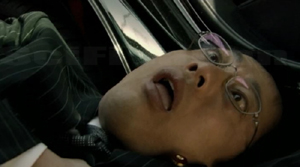 One of Light`s first victims is the Deputy Director of the Foreign Ministry, suspected of crimes against children. © 2006 [Death Note] Film Partners
One of Light`s first victims is the Deputy Director of the Foreign Ministry, suspected of crimes against children. © 2006 [Death Note] Film PartnersStill unconvinced however, Light tests the notebook once more, only to have what appears to be his greatest fears come true: the notebook is real. Unlike most students, rather than be frightened of this power, Light chooses to embrace it. Within only a few days, Light manages to write hundreds of criminals’ names into the notebook, in an attempt to cleanse the world of evil and all crime. One night, whilst in his room, Light is confronted by a beastly creature named Ryuk (voiced by Shido Nakamura). Ryuk confesses that he dropped the notebook, and that he is in fact a Shinigami (Death God, something like a soul reaper). He comes from the Shinigami world, where there are more like him. Their sole job is to write the names of humans in their notebooks, extending their lives by doing so. However, if a Shinigami accidentally drops their Death Note into the human world, the human who picks it up becomes the owner. Ryuk explains that the only thing a Shinigami can do at that point, is follow the human around until they give it up, or die. Light proceeds to proclaim his intentions: to become the God of a new world; a world without violence, crime or evil. Ryuk grins, and notes to himself that “Humans truly are interesting”. Light becomes known online as the God ‘Kira’.
Meanwhile, the International Criminal Police Organization (ICPO) is trying to find any clues as to how these murders are being committed. They call upon the greatest detective alive; a man whose face has never been seen, and who’s name is unknown to all. A man known only as “L” (Kenichi Matsuyama). Who will win the battle of wits? The mass murderer Kira, or the unknown detective L? The film version of DEATH NOTE is not so different in it’s basic story. It does however take a few liberties as far as adapting the plot is concerned. A new character is added to the film, Shiori Akino (Kashii Yuu). Shiori is Light’s girlfriend in the film, and a character that plays a pivotal role in the final third of the movie. Perhaps one of the most controversial aspects of this film, was how director Kaneko would change the story to suit the film format. Most films based off of manga/anime suffer from a shortened storyline, which tends to greatly diminish the impact of the story. Online message boards were rumbling with anticipation: would the important cerebral aspect of the manga be maintained? Much of the dialogue in the original manga was internal. Both L and Light have many long and drawn out monologues in their mind, which would normally lead to some major pacing issues in a feature length film. With such previous failed manga/anime to film adaptations as DEVILMAN (Debiruman, 2004), fans had reason to be concerned, especially with the immense popularity of Death Note. Fortunately for fans, and moviegoers worldwide, Shusuke Kaneko’s DEATH NOTE is a resounding success. THE CHARACTERS
Playing the diabolical and scheming Light Yagami, is Tatsuya Fujiwara, up and coming star in Japan. Much was made of Kaneko’s decision to cast Tatsuya as Light. Chief among the concern was the fact that the actor looks very little like Light Yagami. However, more important than appearance is whether or not Fujiwara was able to embody the attributes that make Light the complex character that he is. This writer is pleased to say that Fujiwara does this in spades. Much like the manga representation of the character, the Light seen in DEATH NOTE is as scheming and genius as ever. Perhaps the biggest difference, is in the fact that the audience sees more of his life outside of killing criminals, and is able to identify with him just a bit more. This is seen via his facial expressions, and the various tones Fujiwara switches between. It creates a subtly more multifaceted character. Fujiwara’s Light also shows a more human side of himself, through his girlfriend Shiori.
Shiori Akino is played by the young Yuu Kashii, known for her role as Paula Atsuko Ebner in LORELEI: THE WITCH OF THE PACIFIC OCEAN (Lorelei, 2005). Shiori is the brand new character added for the DEATH NOTE movie, and is the girlfriend of main character Light Yagami. At first, Kashii’s character seems to be something of an unnecessary addition. This is not entirely unwelcome however, as she provides a means for which Light to show a more caring, loving side. This is most evident through the date the two have at the midway point of the film. By the end however, she becomes a key addition to the climax, adding a sense of urgency that otherwise wouldn’t have been there. Kashii plays Shiori intelligently, giving off the impression of a very independent girl, but one who trusts Light one hundred percent even when faced with the theory that he may well be Kira.
The brilliant detective L is played by Kenichi Matsuyama, the co-star of the hit film NANA, also a manga adaptation. Part of what makes L who he is, is his appearance. The character himself is very eccentric, and extremely peculiar in his movements. He sits in his chair a certain way, eats only sweets, and tends to hold things in the most awkward of ways. This meant that the actor would have to constantly be in highly uncomfortable positions, which could prove to be taxing on the body. Kenichi Matsuyama not only succeeds in resembling L physically, but also in his gestures and movements. The small things like the way in which he sips his coffee, or tucks his legs in on a chair, create an interesting if not thoroughly engaging character. What has driven him to this social awkwardness? Much of Matsuyama’s acting is vocal as well; L does not make an appearance on the screen until past the halfway mark. In this regard, he is just as successful. Kenichi Matsuyama does an excellent job in completely embodying what L is.
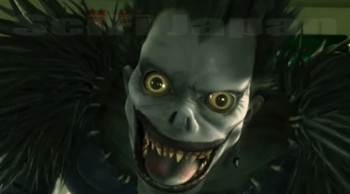 The apple-loving CG character Ryuk the Death is voiced by Shido Nakamura. © 2006 [Death Note] Film Partners
The apple-loving CG character Ryuk the Death is voiced by Shido Nakamura. © 2006 [Death Note] Film PartnersShinigami Ryuk, is voiced by well-known actor Shido Nakamura. Some of Nakamura’s most famous roles are Tanaka Anno from FEARLESS, Mamoru Uchida in YAMATO, and No. 13 in NEIGHBOR NO. 13. For this film, director Shusuke Kaneko opted to go for an entirely Computer Animated version of Ryuk. This in itself is a daunting task, especially considering Ryuk is onscreen for a large percentage of the film’s running time. This includes both night and day scenes. Visually speaking, Ryuk is stunning, and is some of the best CG put to Japanese film, save for perhaps SINKING OF JAPAN (Nihon Chinbotsu, 2006). He moves unnaturally, but this is part of his character. Each feather on his wings is individually rendered, and things as small as the satchel for his book have exquisite detail to them. Even in the sunlight, Ryuk’s appearance does not falter, and consistently great quality is achieved throughout the entire film. Yet, regardless of how well constructed the character model is, the aspect that truly brings Ryuk to life is Nakamura’s dark, gritty voice. It’s as sarcastic and mischievous as one might expect, and really makes Ryuk a believable character, despite how unnatural he looks when placed against the backdrop of the city.
Shigeki Hosokawa plays FBI agent Raye Iwamatsu. Hosokawa is known for his roles as Hibiki from MASKED RIDER HIBIKI (Kamen Raidaa Hibiki, 2005), and a brief role as the groom in GREAT TEACHER ONIZUKA (GTO, 1999). In the manga version Raye plays a key, but small role. However, as a result of the length of the movie, Raye’s role becomes even more key. Hosokawa plays the role relatively straight, and really doesn’t bring upon himself many complaints. One scene that sticks out in his performance is the subway train sequence. Hosokawa portrays the ambivalent feelings of a man who has to choose between essentially murdering all of his fellow agents, or allowing innocent bystanders to be killed.
Raye’s fiance Naomi Misora is played by Asaka Seto, who also played Takako Nozoe of ONE MISSED CALL 2 (Chakushin Ari 2, 2005). Unlike in the manga, Naomi becomes a hugely important character in the film, and is responsible for the finale of the film, which is very different from the direction the manga heads in at this point in the story. Seto plays Naomi with a ruthless determination, willing to stop at nothing to find the true Kira and murder him for killing her fiance. Perhaps the scene which most epitomizes this is when Naomi meets Light face to face and begins to question him about the bus hijack incident. Clearly Light is against the ropes, and even Shiori intervenes in defense of her boyfriend. Naomi does not back away however, and her eyes are cold as if she has nothing left to lose. This is certainly a testament to Seto’s acting abilities.
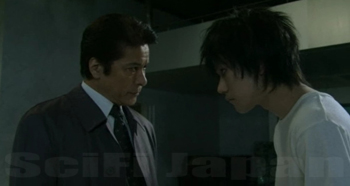 Police Chief Soichiro Yagami (Takeshi Kaga) has words with Detective L (Kenichi Matsuyama). © 2006 [Death Note] Film Partners
Police Chief Soichiro Yagami (Takeshi Kaga) has words with Detective L (Kenichi Matsuyama). © 2006 [Death Note] Film PartnersLight Yagami’s father, Soichiro Yagami, is played by none other than Takeshi Kaga, host of IRON CHEF, as well as voice of Alien Benzen and photojournalist Akuma Ogami in ULTRAMAN ZEARTH (Urutoraman Zeasu, 1996). Chief Yagami is a very determined, if not overly serious man of the law, and Kaga plays him exactly in that way. Out of the entire cast of characters, he is seemingly the most normal and stable. Though, he contains a deep loyalty to both his family and the force, as evident by the fact that he chooses to not resign, even when Kira murders the FBI agents. Kaga presents a surprisingly serious performance, especially for those familiar with him only through IRON CHEF. The scene in which he watches as the majority of the police force departs, is one of the most powerful in the film. The rest of the cast delivers solid performances all around. Erika Toda gives a glimpse of what is to be expected of her as Misa Misa. Shunji Fujimura plays L’s confidant, Watari, with a certain proud aura that comes with age.
COMMENTS
The cinematography of the film is suitably dark, and almost edgy in nature. Shots are clean, but contain a certain contrast of light versus dark that fits with the theme of the film: good versus evil. Scenes in which Light is the central character seem to have a lower level of light than those with L, which are bright, and tend to lean more toward a white palette. Perhaps the perfect example of this, are the final shots of the film, in which L and Light come face to face for the first time. The area is lit, but somewhat dimly. Unlike the shots with either characters, this setting is neither light, nor dark. It walks the line between the two, creating an interesting combination, as if to say the two men are at a stand still. Cinematographer Hiroshi Takase is to be commended for this meticulous level of detail.
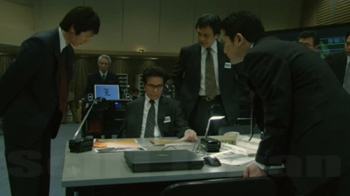 Chief Yagami (Takeshi Kaga, center) and the police investigation team hunt for the mysterious killer called `Kira`. © 2006 [Death Note] Film Partners
Chief Yagami (Takeshi Kaga, center) and the police investigation team hunt for the mysterious killer called `Kira`. © 2006 [Death Note] Film PartnersMusically, Kenji Kawai pulls through once again. In all of his past projects, he tends to add a level of quality that often times makes a film feel more epic than it truly is. Unlike films such as DRAGON TIGER GATE, or SEVEN SWORDS (Chat Gim, 2005), however, the score here is far more ambient, and is meant to accompany a scene rather than overpower it. Rarely is the music ever louder than the sound effects or dialogue here. Perhaps the only track in the film that reaches a powerful, theme song level is “Go into Battle”, the track that plays over the first meeting between L and Light. It’s a piece that slowly builds into a guitar and synthesizer chord that perfectly represents the drama about to unfold in the final half of the story. The official movie soundtrack comes highly recommended. The writing in the film is consistently one step ahead of the viewer, and keeps the audience on their feet. While most of the scenarios are straight out of the manga, much of the story is original. However, these scenes are just as intelligent and shocking as the ones that come before them. For instance, the meeting of L and Light, and the events that lead up to it, are drastically different from what is in the original source material, but it is equally as engaging, and completely apart of how these characters would interact with each other. Tetsuya Oishi has done a spectacular job in adapting the cerebral dialogue to the screen. Perhaps the only complaint is that in the beginning the film drags a little bit. Though this is to be expected considering the amount of information that needs to be delivered to the viewer in a short amount of time.
Director Shusuke Kaneko has done a spectacular job in bringing a well-loved property to the big screen. If critical success is not indicative of this, than perhaps the financial success is. DEATH NOTE in it’s Japanese release had an opening weekend take of $4 million (US), and earned more than $24 million total in it’s run in Japan. This doesn’t include the constantly increasing international releases in countries such as China and Singapore. If the box office is any indication, then clearly the sequel DEATH NOTE: THE LAST NAME is as good, if not better than this first film, having brought in $19,343,415 in only two weeks in Japan alone. Both films opened at number 1, which marks a first for Kaneko. DEATH NOTE was recently screened at the American Film Market, and NTV is currently shopping the film around in multiple countries.



